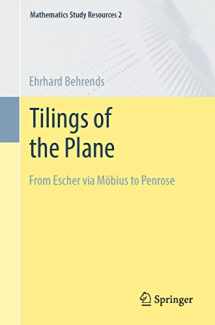
Tilings of the Plane: From Escher via Möbius to Penrose (Mathematics Study Resources)
Book details
Summary
Description
From the Back Cover
The aim of the book is to study symmetries and tesselation, which have long interested artists and mathematicians. Famous examples are the works created by the Arabs in the Alhambra and the paintings of the Dutch painter Maurits Escher. Mathematicians did not take up the subject intensively until the 19th century. In the process, the visualisation of mathematical relationships leads to very appealing images. Three approaches are described in this book.
In Part I, it is shown that there are 17 principally different possibilities of tesselation of the plane, the so-called "plane crystal groups". Complementary to this, ideas of Harald Heesch are described, who showed how these theoretical results can be put into practice: He gave a catalogue of 28 procedures that one can use creatively oneself - following in the footsteps of Escher, so to speak - to create artistically sophisticated tesselation.
In the corresponding investigations for the complex plane in Part II, movements are replaced by bijective holomorphic mappings. This leads into the theory of groups of Möbius transformations: Kleinian groups, Schottky groups, etc. There are also interesting connections to hyperbolic geometry.
Finally, in Part III, a third aspect of the subject is treated, the Penrose tesselation. This concerns results from the seventies, when easily describable and provably non-periodic parquetisations of the plane were given for the first time.
The ContentsPart I: Escher seen over the shoulders- Part II: Möbius transformations - Part III: Penrose tesselation
The AuthorProf. Dr. Ehrhard Behrends, Free University of Berlin, Department of Mathematics and Computer Science, is the author of numerous mathematical textbooks and popular science books.
The aim of the book is to study symmetries and tesselation, which have long interested artists and mathematicians. Famous examples are the works created by the Arabs in the Alhambra and the paintings of the Dutch painter Maurits Escher. Mathematicians did not take up the subject intensively until the 19th century. In the process, the visualisation of mathematical relationships leads to very appealing images. Three approaches are described in this book.
In Part I, it is shown that there are 17 principally different possibilities of tesselation of the plane, the so-called 'plane crystal groups'. Complementary to this, ideas of Harald Heesch are described, who showed how these theoretical results can be put into practice: He gave a catalogue of 28 procedures that one can use creatively oneself – following in the footsteps of Escher, so to speak – to create artistically sophisticated tesselation.
In the corresponding investigations for the complex plane in Part II, movements are replaced by bijective holomorphic mappings. This leads into the theory of groups of Möbius transformations: Kleinian groups, Schottky groups, etc. There are also interesting connections to hyperbolic geometry.
Finally, in Part III, a third aspect of the subject is treated, the Penrose tesselation. This concerns results from the seventies, when easily describable and provably non-periodic parquetisations of the plane were given for the first time.


We would LOVE it if you could help us and other readers by reviewing the book
Book review



